井上廣子 INOUE Hiroko
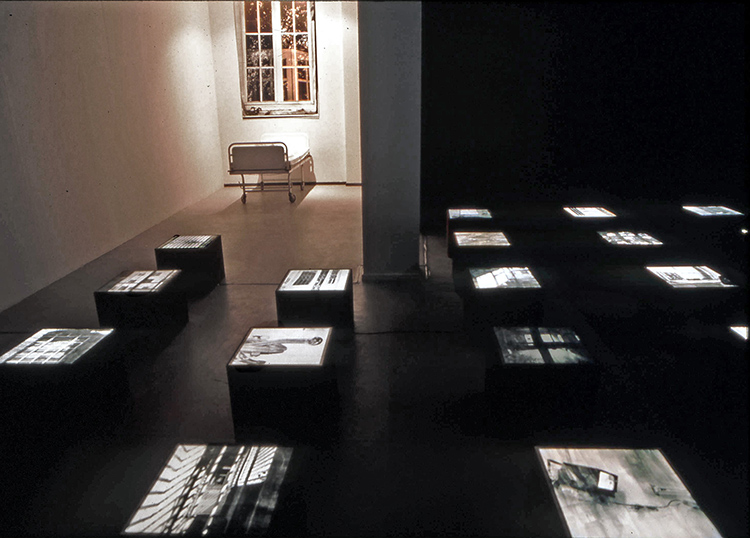 《Absence》1999年 ゼラチンシルバープリント、布、ライトボックス 45×45×45cm (25点)
《Absence》1999年 ゼラチンシルバープリント、布、ライトボックス 45×45×45cm (25点)
デュッセルドルフ市立ギャラリー、アトリエ アム エック企画 個展 展示風景、撮影:フランク・ピータース
栃木県立美術館蔵
Absence, 1999, Gelatin Silver Print, Cloth, Light Boxes, 45×45×45cm (25 pieces)
Exhibited at the solo exhibition, curated by Atelier am ECK, City Gallery of Düsseldorf, Photo by Frank Peters
Collection of Tochigi Prefectural Museum of Fine Arts
井上廣子
INOUE Hiroko
大阪府生まれ、奈良県在住、活動。1999年よりドイツにスタジオを持ち、デュッセルドルフ、ベルリン、ウィーンでも活動。
日本からドイツ、オーストリア、北米など、世界を飛び回って活動する井上廣子にとって、1974-75年文化人類学のフィールドワークで滞在した沖縄での経験が、その後のアーティストとしての活動の精神的な根幹となったという。1990年代に初めファイバーワークの作家として出発するが、1995年の阪神・淡路大震災の経験を契機として、隔離された人間の心の痛みや、人と人を隔てる境界をテーマにした作品を制作。隔離施設(精神科病院、刑務所、収容所跡など)の窓をモティーフとした写真作品や、目を閉じて直立した世界各地の高校生の写真インスタレーション《Inside-Out》(2005年、ウィーン)で高い評価を得た。
《Mori:森》は、2011年、東日本大震災以後に制作された近作で、同年9月にまずドルトムントの個展で発表され、その後、2012年4月に被災地で撮影された風景を加えて、新たに構成されたインスタレーションである。それらはドイツと日本の森の写真だが、暗い森の記憶が漂白されたような輝きを放つ。ドイツの森には、ルール工業地帯の廃坑になった炭鉱付近の人工林の風景や、第二次大戦の激戦地となったライヒスヴァルトの森が選ばれた。井上が撮る森は、それぞれ固有の物語を持つ。日本では、国造り神話に遡る太古の地、奈良の森がまず撮影された。新たに撮られた東北の被災地の風景は、ドイツと日本の森と並んで、未来への希望を語ることが出来るだろうか。
小勝禮子 井上廣子・作品解説『アジアをつなぐ-境界を生きる女たち1984-2012』展図録(福岡アジア美術館ほか、2012年)より一部抜粋
井上廣子-新たな写真作品(一部抜粋)
ゼップ・ヒーキッシュ=ピカルド(ドイツ・ボッホム市立美術館 副館長)
彼女は写真、インスタレーション、写真彫刻で社会的テーマに熱心に取り組んでおり、近年ますます環境問題やテクノロジー問題が作品において決定的役割を果たすようになっている。
アーティストにとって大事なのは、日常世界の隠された次元や抑圧された次元を強調することだ。1995年の阪神大震災という深く大きな障害を与える体験に刺激され、井上は、社会的トラウマならびに個人的トラウマに取り組もうという思いを強くする。福島の震災は高度のテクノロジー文明とその進歩に対する盲信、人間によって完全に支配されえない自然・環境との相克を浮かび上がらせ、それが彼女の主要テーマとなっている。
井上の写真作品は、自然の摂理は同時に人間の本性であり、外的自然は同時に人間の内なる自然でもあること、すなわち人間自身が自然の一部であることを再び理解すべきだと呼びかける。井上廣子の作品は何年も前から、その推進力と感覚的に把捉できるモデルを供給している。
(和訳:鈴木芳子)
Born in Osaka, Japan. Lives and works in Nara, Japan and also works in Berlin, Dortmund, Germany and Vienna, Austria.
Inoue Hiroko has traveled and worked around the world in places including Germany, Austria, and North America. But the spiritual root of her work lies in the experiences she had in Okinawa doing field work in cultural anthropology. She became a fiberwork artist in in the 1990s, but the 1995 Great Hanshin Earthquake led her to create works with themes like the pain of those in isolation and the boundaries which exist between people. Her photographic works create a theme out of the windows of quarantine institutions such as insane asylums, prisons and refugee camps. They, as well as her Inside Out photo installation of high school students with their eyes closed (2005, Vienna), have received high praise.
Mori (Forest) is a recent work made after the 2011 Great East Japan Earthquake. It was first displayed at an individual exhibition in Dortmund in September of the same year, and was reconfigured in 2012 with shots taken in the disaster area itself. Next are her photos of the forests of Japan and Germany, which give off a light that seems to bleach the dark forests’ memories. For the German forests, she chose an artificial forest near the mine that has since been abandoned in the Ruhr industrial area, and the Reichswald forest that had been the site of a bloody battle in the Second World War. The forests in Inoue’s photos each have traditional stories that go with them. In Japan, an ancient land tied to national myths, the Nara Forest was the first subject of her photos. Can her new photos of the scene of the Great East Japan Earthquake, alongside her photos of the forests in Japan and Germany, tell us about her hopes for the future?
-Excerpt from the comment about INOUE Hiroko in Women In-Between: Asian Woman Artists 1984-2012 (Exh. Cat.), Fukuoka Asian Art Museum, 2012(KOKATSU Reiko / Translated by Sam Innes)
Hiroko Inoue – New photographic work (excerpt)
Seep Hiekisch-Picard, Deputy Director, Kunstmuseum Bochum
She is deeply involved with social themes in her photographs, installations and photo-sculptures that the environmental and technology issues have become decisive roles in her works more and more in recent years.
The important thing as an artist, there is a concern with the retrieve hidden or repressed aspects of our daily life in this world. Hiroko Inoue has been to put serious efforts to dealt with social trauma as well as personal trauma that the traumatic experience of the Great Hanshin Earthquake in 1995 gave the impulse; the disaster of Fukushima highlighted the blind belief in advanced Technological civilization and its progress, and conflict between the nature and the environment which cannot be completely dominated by human beings. It has become her principal theme.
Inoue’s photographic works warn you that we should realize again human beings is as a part of the nature that the law of nature is human nature at the same time, external nature is also internal human nature simultaneously. Hiroko Inoue’ works has provided this as the ready for thought and sensuously comprehensible models for years.
(Translated by TSUKAMOTO Yasuko)
更新された最新の情報は、作家および画廊のウェブサイトをご覧ください。
Please refer to the artist’s and the gallery’s website for new updates.
https://hiroko-inoue.com/
https://gallery-inoue.com/artists/hiroko-inoue/
大阪府20世紀美術コレクション 井上廣子《封印された布貌》アーティスト・インタビュー、2021年8月6日
INOUE Hiroko, Artist Interview, August 6, 2021
https://www.enokojima-art.jp/inouehiroko2021
AWARE : Archives of Women Artists, Research & Exhibitions
https://awarewomenartists.com/en/artiste/hiroko-inoue/
AWARE-日本

《 inside-out 》2005年 インクジェットプリント、アクリル板、ライトボックス 94×64×15cm(17点)
オットーワグナー精神病院、ユーゲントシュテール・テアター企画 個展 展示風景(オーストリア・ウィーン)
inside-out, 2005, Ink-jet print, Acrylic resin, Light Boxes 94×64×15cm (17pieces)
Installation view at the solo exhibition, curated by Jugendstiltheater, Otto-Wagner-Spital, Vienna, Austria

《 inside-out 》2005/2011年 インクジェットプリント (各120×60×0.5cm×18点)、スチール円管(直径700cm)、アクリル板 ウィーン美術館企画 コレクションによる 個展 展示風景 撮影:マイケル・ネトウセック
inside-out, 2005/2011, Ink-jet print (120×60×0.5cm each×18pieces), Steel (ø700cm), Acrylic resin
Installation view at the solo exhibition, Wien Museum MUSA, Vienna, Austria, Photo by Michael Netousek
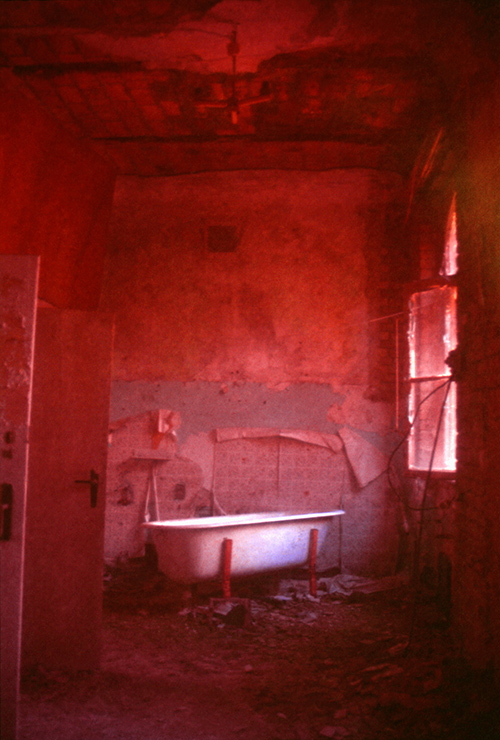
《Inside-out》2011/2018年修正 インクジェットプリント 90×60cm
Inside-out, 2011/2018 Retouching, Ink-jet print, 90×60cm
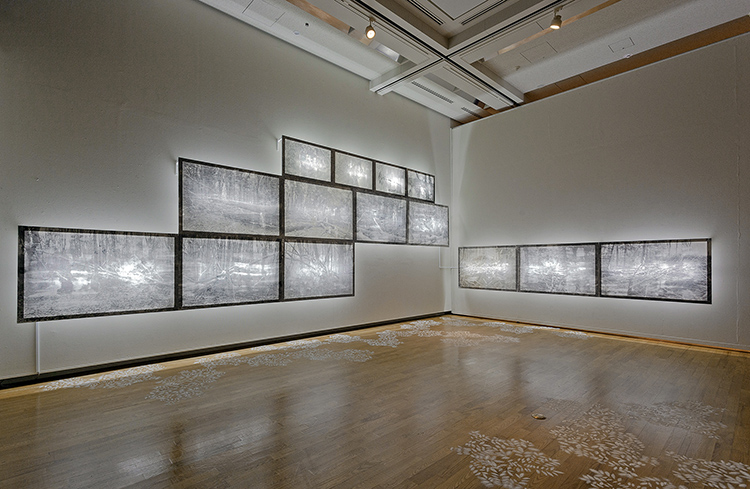
《Mori:森》2012年 ゼラチンシルバープリント(各90×120×5cm×10点、各60×90×5cm×4点)、布、木、蛍光灯、塩
「アジアをつなぐ -境界を生きる女たち 1984-2012」福岡アジア美術館 展示風景 撮影:泉山朗土
Mori, 2012, Gelatin Silver Print (90×120×5cm×10pieces, 60×90×5cm×4pieces), Cloth, Wood, Lamp, Salt
Installation view at the group exhibition Women In-Between: Asian Women Artists 1984-2012, Fukuoka Asian Art Museum, Japan Photo by IZUMIYAMA Road
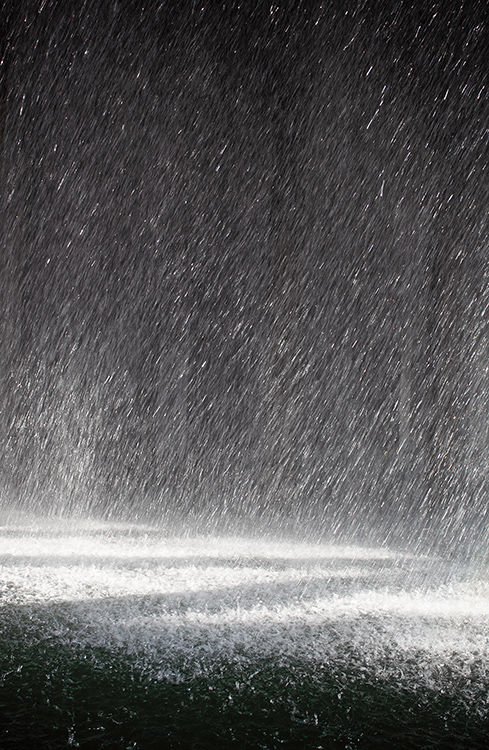
《MIZU》2016/2019年修正 インクジェットプリント 90×60cm
「大芸術祭」展出品 クンスト パラスト (ドイツ、デュッセルドルフ)
MIZU, 2016/2019 Retouching, Ink-jet print, 90×60cm
Exhibited at the Grosse Kunstausstellung, Kunst Palast, Düsseldorf, Germany

井上廣子 《Being in the face》 2024年 インクジェットプリント、ワックス23.6×17.2×0.2 cm
Hiroko Inoue, Being in the face, 2024, Ink-jet print, Wax, 23.6×17.2×0.2 cm
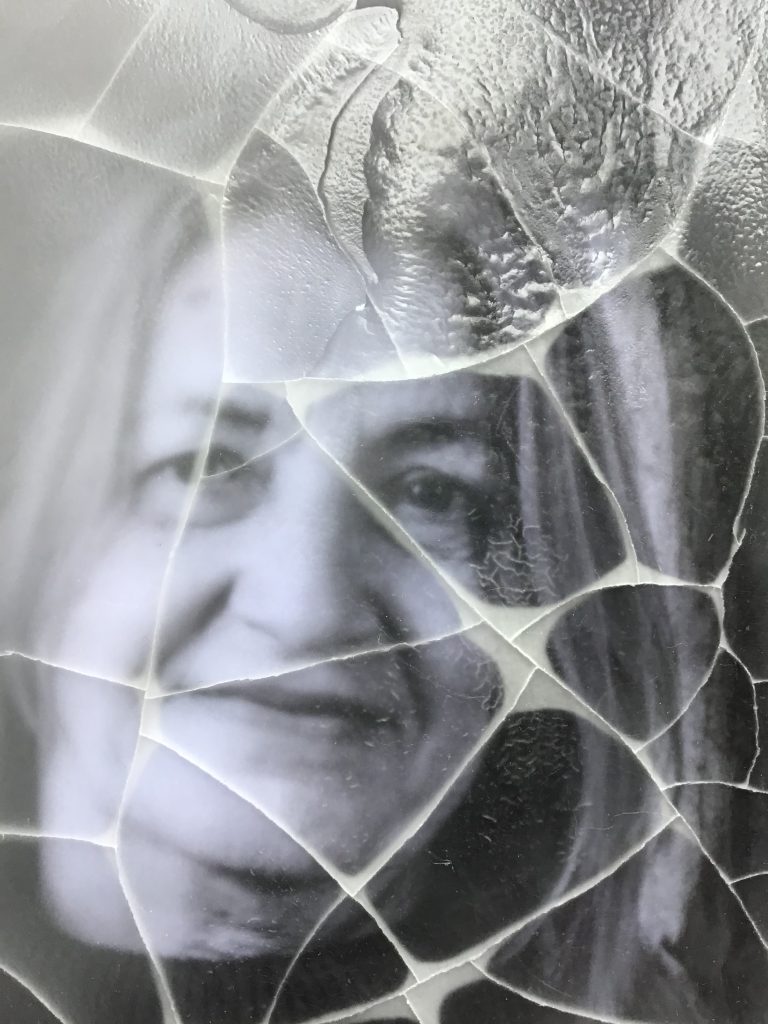
井上廣子 《Being in the face》 2024年 インクジェットプリント、ワックス23.6×17.2×0.2 cm
Hiroko Inoue, Being in the face, 2024, Ink-jet print, Wax, 23.6×17.2×0.2 cm

